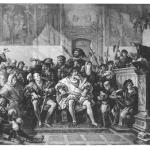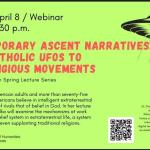Washington D.C., Aug 31, 2017 / 03:02 am (CNA/EWTN News).- Inside a Greek Orthodox Cathedral in the middle of Washington, D.C., self-described “geeks” decorated the meeting hall to look like the “Lantern Waste” of C.S. Lewis's Chronicles of Narnia. Over the course of a weekend, the hall's snow-covered tabletops and frosted windows were replaced with flowers and bright colors, as springtime came for Narnia. In the meantime, a group of video game characters, Star Trek crew members, Marvel heroes and villains from Narnia itself hustled back and forth to talks on Christian themes in horror films, the brokenness of the world, and the meaning of death in the Doctor Who series. Neither the topics of the talks nor the importance of the shifting scenery were lost on attendees of Christian Sci-Fi and Fantasy convention Doxacon – a gathering its organizers jokingly refer to as “Christian ComiCon,” when not lauding its “Geek Orthodox” credentials. Like the warming of Narnia occasioned by Aslan's sacrifice, the sci-fi and fantasy fans hope that Christian reflection on the greatest stories and fictional worlds of today can shed light on the good, the beautiful, and the enchanting truths reflected in these works. “Great stories are just something everybody loves (and they) go deeply into the humanity that a lot of the culture can't do,” Edmund Lazzari, a Doxacon attendee, told CNA. He said that many of the authors, TV shows and films discussed during the weekend point to “something deeper,” and that questions like “can aliens be saved,” or considerations surrounding liturgy and worship in space or on other worlds, can lead to fruitful reflection on the Gospel. “I love these sorts of conversations and I'm so glad to be in a place where we can have these conversations.” Lazzari said that Christians have something important to bring to all aspects of the world – even stories as fantastical and strange as these. “You can see everything in the light of theology,” he said. “There's nothing authentically human that’s alien to the Catholic faith.” “Looking at these stories that have aspects of humanity in them – the good and the bad all in display – we've definitely got something to say.” Lazzari joined about 80 other fans of science fiction and fantasy at Doxacon, held this year in Washington, D.C. The fourth annual event gathered a crowd of just under 100 people to St. Sophia Greek Orthodox Cathedral, with various talks and discussions held throughout the building. The conference, put on by a team of local science-fiction and fantasy fans incorporates a Christian worldview while looking at topics within the genres. This year’s Doxacon talks spanned topics such as beauty within fantasy, mortality within the Doctor Who series, the authority of faith and of people on the margins within horror films, and loving one’s enemies in stories like Beauty and the Beast. Since the first conference held in Washington, D.C. in 2013, other Doxacon conferences have also been held in Toronto and Seattle. The exploration of science fiction and fantasy through a Christian perspective was something, Father David Subu, found lacking both at other science-fiction meetings as well as within many Christian spaces. Fr. Subu is an Orthodox priest in Fairfax, Virginia and one of the founders of Doxacon. He told CNA that one day, he found himself talking to other Christians about some of their favorite sci-fi series and wishing they could have the same kind of deep conversations about these topics on an openly Christian setting. “We were lamenting one year how they have these amazing conventions like ComiCon, but there's not really a venue that existed to explore those ideas from a Christian point of view,” he said. “For so long, Christians were told from both sides that these worlds can't mix.” In his experience, he said many Christians can be distrustful of some elements of science fiction and fantasy, or discount an entire genre because of problematic elements within one book or show. Meanwhile, many fans of these works try to prove they're the “smartest person in the room,” by promoting explicitly atheistic readings of various stories or themes. This apparent disconnect between sci-fi fandoms and Christianity is all the more concerning given the genre's audience, he pointed out. “The majority of people consuming fantasy fiction and sci fi are like the rest of America: they're Christian.” Daniel Silver, another one of Doxacon's founders, said the presumed tension between fandom and faith is part of what inspired him to help put the conference together. Growing up in an Evangelical Christian home, “I had been told by my church that these genres were not for me.” After converting to the Orthodox faith, he discovered that “there are other people like me who enjoy these things who are geeks and nerds” – but also devout Christians. Silver said that the conferences have also been an opportunity to both share some of the life of the faith as well as to reach out across denominational lines. Since its inception, the group has brought together speakers and attendees from a variety of Christian traditions: Catholic, Orthodox and Protestant. Still, Silver added, the conference makes sure to incorporate elements of the Orthodox tradition its founding organizers. At the beginning of the conference, attendees gathered to sing an Akathist prayer: a chanting song of praise focused on the goodness of God and of all creation. The melody resounded in the main dining hall, a reminder that God has already enchanted this world and blessed it with an abundance of beauty and goodness. Before dinner at the end of the conference, the busy schedule was stopped so that everyone could gather to pray Vespers: one of the traditional hours of the Church and a marker of time in both the Eastern and Latin Churches. These two breaks for prayer bookended a busy schedule of discussions and debates. While prayer was a core of the convention weekend, so was discernment. One of the keynote talks by Catholic writer Leah Libresco focused on the idea of brokenness within different magical worlds. In the “Young Wizards” series by Diane Duane, magic is used to help heal the brokenness and chaos in this world – an analogy for the Christian approach to sin that Libresco said was a helpful touchstone during in her conversion. Meanwhile, in “The Magicians” series by Lev Grossman, magic serves as an extension of its characters' pain, hurt and anger, and Libresco heartily encouraged all to stay away from the series. Stephanie Subu, another one of the conference organizers, said that this kind of differentiation of themes within seemingly similar books is also an important aim of the conference. She admitted that not every story is appropriate for Christians to engage with – some stories have elements that promote worldviews or actions that challenge Christian faith and life. “There's stuff out there that yes, really is not good to read and unless you have the tools and the spiritual eyes to know the difference.” Several talks at the event aimed at parents and children continued this conversation, focusing more explicitly on what themes and examples of goodness to look for in good fiction and fantasy – and how to know is something is worth putting back on the shelf. Still other attendees appreciated the philosophical depth and seriousness speakers brought to these stories – some of which can be brushed off as fanciful or even childish. Felix Miller, an attendee who heard about the event from a friend, said that it was this seriousness he appreciated the most. “I really liked the idea of fantasy/sci-fi/pop culture and more rigorous philosophical and cultural considerations. One of the things I've liked is that the presenters have done a really good job of not presenting the conversation in a shallow way.” “They're doing a really good job of taking the texts seriously and engaging with them in a theological bent,” he told CNA. Miller said he hoped some of what he heard this weekend could lay the groundwork for further discussions about some of his favorite shows and books after Doxacon. “People are dealing with a lot of these same questions, but maybe aren't dealing with them in the same way with careful philosophical distinctions,” he noted. Erin Gillaspy – who wore a shirt emblazoned with the words “Ask me about Space Catholics” – also appreciated the opportunity to talk about philosophy and theology – as well as the chance to discuss the difficulties of setting liturgical calendars for astronauts. She commented that, while some fictional worlds might have elements that are dark, fantastical or ridiculous, these stories provide the opportunity to speak to a wide audience about the truth of the human condition. This truth, Gillaspy said, is something that Catholics can dialogue with, no matter the context. “The truth is not going to stop being true. Just because you happen to put that truth on a rocket ship or in deep space or on Mars or on Pluto or on the Moon, they’re not going to stop being true – they’re immutable truths,” she said. However, she also said that while a Catholic can see the enchantment and truth within a number of stories, Christians also need to be actively engaged not only in interpreting these worlds, but creating them too. “The only major players in science fiction and fantasy these days who are Catholic are JRR Tolkien and Gene Wolfe – and Gene Wolfe is not super well-known,” she pointed out. “I mean this lovingly, but there's gotta be more representation.” Lazzari – who joined Gillaspy in explaining the challenges and opportunities facing “Space Catholics” – agreed. “A lot of times what happens in our culture is that Christianity is one aspect of our society. You’ve got economics, you’ve got politics, you’ve got religion, you’ve got the arts, but really, the great thing here is that our view is a whole worldview.” “[Christianity] is not a box you check, it's a way of life, it's a way of seeing the world.” Read more




















